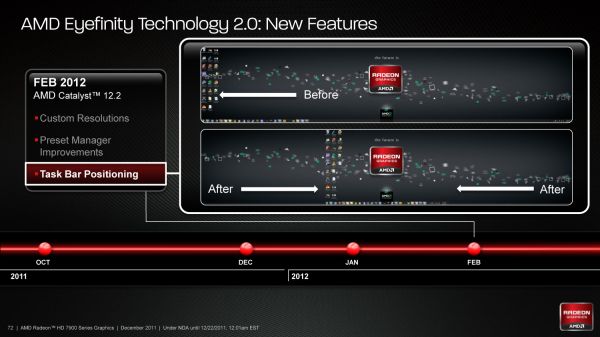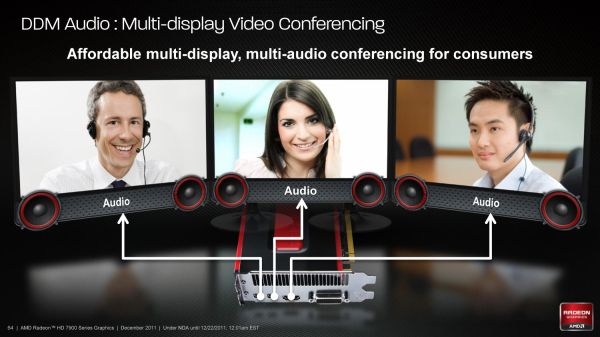AMD Radeon HD 7970 Review: 28nm And Graphics Core Next, Together As One
by Ryan Smith on December 22, 2011 12:00 AM EST- Posted in
- GPUs
- AMD
- Radeon
- ATI
- Radeon HD 7000
Display Tech: HD3D Eyefinity, MST Hubs, & DDM Audio
With the launch of the HD 5000 series back in 2009 AMD managed to get the drop on everyone, press and NVIDIA alike. Eyefinity, AMD’s Single Large Surface technology, came out of virtually nowhere thanks to a carefully orchestrated development plan that ensured very few people even within AMD knew about it. As a result of everything that was leaked ahead of time Eyefinity was not, making it AMD’s big eye catcher for the 5000 series.
As what was to be the first piece of the much dreamed about holodeck, AMD has been steadily working on it since 2009 in order to improve the experience even within their existing hardware by adding support for such features as bezel compensation and combining CrossFire with Eyefinity. For AMD it’s a feature of great importance even if end user adoption is still limited.
For the Southern Islands family AMD isn’t going to be pulling quite the rabbit out of their hat this time when it comes to displays. Southern Islands’ new display feature will be Discrete Digital Multi-Point Audio (which we’ll get to in a moment), but this doesn’t mean that AMD hasn’t continued to work on Eyefinity. Since October AMD has been engaged in an initiative they’re calling “Eyefinity Technology 2.0”, which is going to be pushed as a big part of the Southern Islands launch even though these are software improvements that will benefit all cards.
So what is Eyefinity Technology 2.0 composed of? We’ve already seen several new features starting with Catalyst 11.10, such as 5x1 portrait and landscape support and flexible bezel compensation support. The next step is going to be integrating Stereo 3D (or as AMD likes to call it, HD3D) into the mix, similar to how NVIDIA has 3D Vision Surround. Catalyst 11.12 introduced the ability to use HD3D with an Eyefinity display setup, and Catalyst 12.1 (preview out now) added support to do that in a CrossFire configuration. The final step is going to be with Catalyst 12.2 in February, which will add support for custom resolutions and the ability to relocate the Windows task bar to an arbitrary screen, two features that users have been asking about for quite some time. Again, all of these improvements are driver side, but they are a major component of AMD’s marketing for Southern Islands.
Speaking about Eyefinity, one issue that comes up time and time again is Multi Stream Transport (MST) hubs. We were introduced to MST hubs back with the launch of the 6800 series, which allowed a single DP 1.2 port to drive up to 4 monitors by taking advantage of the high bandwidth of DP1.2 and embedding transport streams for several monitors into the signal. The purpose of MST hubs was so that users could use several monitors with a regular Radeon card, rather than needing an exotic all-DisplayPort “Eyefinity edition” card as they need now.
But as many of you have asked me about, several deadlines for MST hubs have come and gone, including the latest deadline which was supposed to be by the end of this year. As with active DP adaptors this is largely out of AMD’s hands since they don’t produce the hardware, but they have been continuing to prod their partners on the issue. The latest deadline from AMD isn’t rosy – summer of 2012 – but they seem more confident of this deadline than deadlines in the past. Not that another half-year wait will be of any comfort for users who have been looking for MST hubs for the better part of the year, but at least it provides some idea on when to expect them.
Last, but certainly not least on the display technologies front is AMD’s new feature for Southern Islands, Discrete Digital Multi-Point Audio (DDMA). It’s a mouthful of a name but the concept is rather simple: it’s the next step in audio output from a video card. Video cards have been able to output audio for a few years now via HDMI, and more recently DisplayPort gained the ability. However GPUs have been limited to streaming audio to a single device, be it a monitor, TV, or receiver. With DDMA GPUs can send audio to multiple devices, and AMD is looking at how to put that ability to work.
The most basic use for being able to send audio to multiple devices is to individually address the speakers of each device, which is the cornerstone of AMD’s proposed use cases. Fundamentally AMD is looking at applications that involve matching audio streams to the monitor the relevant application is on – move a video player from your center monitor to your left monitor, and the audio from that video player should also move from the speakers on the middle monitor to the speakers on the left monitor. What can you do with speakers that are mapped to monitors? That’s what AMD wants to find out.
Being realistic for a moment, the 7970 isn’t going to be the card that sells this feature, as it’s a $550 gamer video card. Gamers are using dedicated 2.1/5.1/7.1 audio systems or headphones for surround sound, and while AMD does have a proposed multi-tasking use case for this it’s not very convincing. DDMA will become much more important on future lower end cards as those are the cards that go into family desktops, workstations, and the like. Thus the killer app for this feature (and certainly AMD’s best prepared scenario) is for video conferencing where each attendee is mapped to a monitor, and with DDMA a set of speakers on that monitor. AMD’s partner Oovoo is working on just such a system though it’s still early in development.












292 Comments
View All Comments
gevorg - Thursday, December 22, 2011 - link
37.9dB is a horrible testbed for noise testing! WTF!mavere - Thursday, December 22, 2011 - link
Seriously!With the prevalence of practically silent PSUs, efficient tower heatsinks, and large quiet fans, I cannot fathom why the noise floor is 37.9 dB.
Finally - Thursday, December 22, 2011 - link
As usual, AT is shooting straight for the brain-dam, I mean, ENTHUSIAST crowd feat. a non-mentioned power supply that should be well around 1000W in order to drive over-priced CPUs as well as quadruple GPU setups.If you find that horrendous they will offer you not to read this review, but their upcoming HTPC review where they will employ the same 1000W power supply...
B3an - Thursday, December 22, 2011 - link
*face palm*1: 1000+ Watt PSU's are normally more quiet if anything as they're better equipped to deal with higher power loads. When a system like this uses nowhere near the PSU's full power the fan often spins at a very low RPM. Some 1000+ PSU's will just shut the fan off completely when a system uses less than 30% of it's power.
2: It's totally normal for a system to be around 40 dB without including the graphics cards. Two or 3 fans alone normally cause this much noise even if they're large low RPM fans. Then you have noise levels from surroundings which even in a "quiet" room are normally more than 15 dB.
3: Grow some fucking brain cells kids.
andymcca - Thursday, December 22, 2011 - link
1) If you were a quiet computing enthusiast, you would know that the statement"1000+ Watt PSU's are normally more quiet if anything"
is patently false. 1000W PSUs are necessarily less efficient at realistic loads (<600W at full load in single GPU systems). This is a trade-off of optimizing for efficiency at high wattages. There is no free lunch in power electronics. Lower efficiency yields more heat yields more noise, all else being equal. And I assure you that a high end silent/quiet PSU is designed for low air flow and uses components at least as high in quality as their higher wattage (non-silent/non-quiet) competitors. Since the PSU is not decribed (a problem which has been brought up many times in the past concerning AT reviews), who knows?
2) 40dB is fairly loud if you are aiming for quiet operation. Ambient noise in a quiet room can be roughly 20dB (provided there is not a lot of ambient outdoor noise). 40dB is roughly the amplitude of conversation in a quiet room (non-whispered). A computer that hums as loud as I talk is pretty loud! I'm not sure if you opinion is informed by any empirical experience, but for precise comparison of different sources the floor should be at minimum 20dB below the sources in question.
3) You have no idea what the parent's age or background is, but your comment #3 certainly implies something about your maturity.
formulav8 - Tuesday, February 21, 2012 - link
Seriously grow up. Your a nasty mouth as well.piroroadkill - Thursday, December 22, 2011 - link
Haha, yeah.Still, I guess we have to leave that work to SPCR.
Kjella - Thursday, December 22, 2011 - link
High-end graphics cards are even noisier, so who cares? A 250W card won't be quiet no matter what. Using an overclocked Intel Core i7 3960X is obviously so the benchmarks won't be CPU limited, not to make a quiet PC.Ryan Smith - Thursday, December 22, 2011 - link
Our testing methodology only has us inches from the case (an open case I should add), hence the noise from our H100 closed loop radiator makes itself known. In any case these numbers aren't meant to be absolutes, we only use them on a relative basis.MadMan007 - Thursday, December 22, 2011 - link
[AES chart] on page 7?